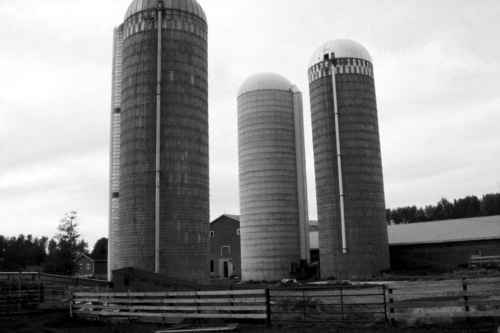| | Nitrogen dioxide characteristics | Health effects | Reducing silo emissions | Protect yourself and others from exposure
Silo gas is formed by the natural fermentation of chopped silage shortly after it is placed in the silo.
The nitrates present in silage crops are converted to nitrites through the fermentation process; they, in turn, react with the organic acids in the silage to form nitrous acid (HNO3). As the temperature of the silage increases during fermentation, the nitrous acid decomposes to form a mixture of oxides of nitrogen, which can include NO, NO2, nitrogen trioxide (N2O3), nitrogen tetroxide (N2O4), and other oxides in lesser amounts (Figure 1).

Figure 1. Silo gas is a health concern.
Nitrogen dioxide (NO2) is of the greatest concern. Nitrogen dioxide levels reach a peak about three days after harvesting and rapidly begin to decrease thereafter. Fatalities from nitrogen dioxide exposures continue despite the long-standing recognition of the hazards.
Nitrogen Dioxide Characteristics
Nitrogen dioxide is a yellowish-brown gas with a bleach-like odour. It has a hazy appearance and is only visible in extremely high concentrations. Nitrogen dioxide is 58 per cent heavier than air, which means it may accumulate on the silage surface or flow down silo chutes and accumulate in low places. The gas is extremely corrosive because of its high oxidation rate.
Health Effects
Nitrogen dioxide causes a burning sensation in the nose, throat and chest. Silo Filler's Disease, which mostly affects farmers, results from inhaling nitrogen dioxide given off by moist silage.
Fluid may develop in the lungs as late as 12 hours after exposure to NO2. Exposure to moderate NO2 levels (50 ppm) may produce cough, hemoptysis (coughing up blood from respiratory tract), dyspnea (shortness of breath) and chest pain.
A level of 50 ppm NO2 has been designated by the US National Institute for Occupational Safety and Health (NIOSH) as immediately dangerous to life and health. Exposure to higher concentrations of NO2 (>100 ppm) can produce pulmonary edema.
Pulmonary edema involves fluid accumulation and swelling in the lungs that may be fatal or may lead to lasting respiratory problems.
The American Conference of Government Industrial Hygienists (ACGIH) has established maximum safe gas concentration, or Threshold Limit Value (TLV), of 3 ppm for an 8-hour work day and 40-hour work week for humans. Severe lung damage may be caused above these limits. Even concentrations of only 15 to 20 parts per million are considered dangerous.
Reducing Silo Emissions
Nitrate can accumulate in silage crops during adverse environmental conditions such as drought. Avoid the accumulation of nitrate in silage crops by applying the proper amounts of manure and fertilizer.
Protect Yourself and Others From Exposure
| 1. | If you must enter the silo to level off or set up an unloader after filling, do so immediately after the last load is in. Do not wait a long time. |
| 2. | Do not allow anyone to enter a silo for 7 to 30 days after the filling process is complete because the fermentation process produces toxic gases. |
| 3. | If you must enter silos during the 30 days after filling stops, or anytime the silo is full or partially full, wear a Self-Contained Breathing Apparatus (SCBA) - equipped respirator. A regular respirator or dust mask will not protect you in an oxygen deficient atmosphere. |
| 4. | Adjust the distributor to level silage during filling operations. Do not level the silo material by hand. |
| 5. | Never enter a silo without someone on the outside monitoring your activity. |
| 6. | Provide extra ventilation to silo rooms and at the bottom of the chute when silos are connected to a barn. |
| 7. | Always ventilate the silo with the blower running at maximum speed for at least an hour before entry, even after the three-week period of greatest danger has ended. Keep the blower running during silo entry. |
| 8. | Lock up all unloading mechanisms. |
| 9. | Farm workers should be alert to the dangers of silo gas. |
| 10. | Close the feed room door to the barn to prevent contaminating the barn areas with nitrogen dioxide gas. |
| 11. | Post "DANGER - DEADLY SILO GAS" signs around the base of the silo to warn visitors, family members and workers to stay away. |
| 12. | Invest in portable gas monitors to test for nitrogen dioxide and oxygen levels. These monitors are the only way to be certain the atmosphere is safe to enter. |
| 13. | Immediately leave the area and get into the fresh air if any nose or throat irritation or shortness of breath is experienced. Should the irritation or shortness of breath continue, seek medical attention promptly. |
Reference
Pratt, D. S. 1993. Respiratory hazards in agriculture: beyond dangerous dust. Seminars in Respir. Med. 14: 8-14.
Prepared by:
Atta Atia, PhD, Manure Management Specialist
Source: Agdex 726-1. August 2004. |
|